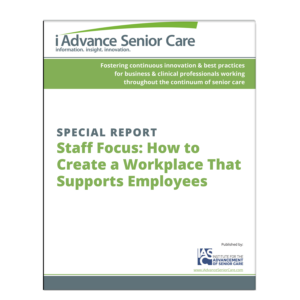Sustaining a person-centered care environment
ACTS Retirement Life Communities (ACTS) has implemented a person-centered care (PCC) initiative throughout its family of 23 continuing care retirement communities (CCRCs) across all levels of care-independent living (IL), assisted living (AL), and skilled nursing (SN). ACTS’ PCC model focuses on honoring the individual and his or her needs, desires, and routine. The intent of the model is to focus less on accomplishing tasks and meeting schedules and more on providing opportunities for residents to exercise choice and continue as much of their normal routine as possible.
ACTS Gerontological Research Institute (AGRI), a research division of ACTS, recently completed an evaluation of ACTS’ PCC experience in collaboration with ECRI Institute, a not-for-profit applied research organization. The specific purpose of this collaborative effort was to assess how PCC initiatives related to environmental features, job roles, and technologic impact resident quality of life (QoL) and staff perceptions of their daily work experience. To evaluate resident QoL and staff perceptions, ECRI Institute conducted a survey of a group of residents and staff from ACTS communities from three geographic regions across the Eastern United States (North, Mid-South, and South). The communities were selected based on (1) having all three levels of care (IL, AL, SN), (2) representing various stages of implementation of ACTS’ PCC model, and (3) having at least 30 AL residents to meet the recommended minimum number of respondents (n = 30).
Methods and analyses
For ACTS’ skilled nursing residents, the Quality of Life assessment instrument developed and validated by Rosalie Kane and colleagues (Kane Wave II) for use in a skilled nursing setting was used without modification. For independent and assisted living residents, ECRI Institute
(www.ecri.org) modified Kane’s survey to account for the increased autonomy and independence of these residents. The reliability and validity of the modified surveys were tested among a randomly selected group of residents from the AL and IL settings. The surveys were further modified and tested until they demonstrated sufficient construct validity and high internal consistency. ECRI Institute also developed a similar survey to measure staff perceptions. The validity and reliability of the staff survey were also tested, and again the results indicated sufficient construct validity and internal consistency.
Final versions of each survey were administered to 524 residents and 392 staff members, and responses were analyzed in the context of how far along each community was in implementing ACTS’ PCC model. The stage of implementation was determined by community leaderships’ responses to an inventory listing key areas of PCC changes. The inventory was closely based on CMS’ Artifacts of Culture Change instrument, but was adapted to address all three levels of care (SN, AL, and IL) within ACTS communities. The inventory covered a broad range of PCC-related practices and services, and included questions addressing practices within key areas (i.e., environmental features, job roles, and technology). Communities were categorized into the following stages of implementation-mostly implemented, partially implemented, or just beginning. The majority of the six communities studied fell within the partially implemented category.
A series of one-way analysis of variance (ANOVA) tests were performed to evaluate the relationship between stage of implementation and the average staff and resident response on each of the survey domains. ANOVA analyses were also used to assess the relationship between stage of implementing PCC practices in key areas and staff and resident responses on survey items related to each area. Additionally, we examined all of the comments included on the organizational inventory and staff and resident surveys to identify potential barriers to implementing PCC initiatives.
Key findings
ANOVA analyses indicated that a positively significant relationship existed between communities further along the continuum of change and the overall mean response of AL residents on survey items within the following domains: relationships, spiritual meaning, and individuality.
Overall, residents and staff across all levels of care responded positively to the surveys. The majority of residents across all communities and levels of care appeared to respond most positively to items measuring the following domains: comfort, functional competence, privacy, dignity, autonomy, and safety. The domains for which some residents expressed less positive responses were: meaningful activity (SN and AL), relationships (SN and AL), spiritual meaning (all care levels), and individuality (SN and AL).
The majority of staff indicated that they positively perceived their relationship with residents, their ability to make decisions about their job, the demands of their job, their feeling of competence, their relationship with their supervisors and coworkers, and their overall acceptance of culture change in their workplace.
No positively significant relationships were observed between stage of implementation and responses of residents in SN and IL and staff.
No significant associations were observed between changes in key areas (environmental features, job roles, and technology) and resident or staff responses on survey items related to the key area.
Barriers to change
A review of the comments provided on the organizational inventory and staff and resident surveys identified a number of potential barriers to implementing ACTS’ PCC model. Comments made by community leaders on the organizational inventory suggested the following barriers: structural limitations of their communities (physical space not conducive to household or neighborhood model), resistance of staff and residents to move from a medical model of care to a new model of care, and lack of or delays in PCC training. Some of these barriers were echoed in the comments of staff and residents, specifically barriers related to resistance to change, structural or physical limitations of communities, and lack of staff training in PCC.
Comments provided on staff and resident surveys identified a number of potential barriers to implementing ACTS’ PCC model.
Staff pointed out additional barriers, such as demands on their workload, lack of communication (e.g., between staff and community leaders, staff and staff, and staff and residents), and compliance with state regulations. Finally, residents across all levels of care suggested the following five obstacles: staff training, staff and resident resistance to change, staff workload, structural limitations within the community, and lack of communication.
What we learned
Overall, findings of the study demonstrate that ACTS’ PCC model has a beneficial effect on the quality of life of residents and the day-to-day duties of staff members at the six communities that participated in this study. This was evidenced by the majority of residents and staff responding positively to the surveys measuring resident QoL and staff perceptions of their daily work experience and awareness of person-centered care within their community. The transformation from a medical model of care to a PCC environment is a journey that can present multiple opportunities to enhance QoL for residents and have a positive effect on staff members. Renovating the physical environment to create neighborhoods, form “gathering” places and small group settings, redecorating shower rooms and eliminating overhead paging, as well as other institutional practices, contribute to enhancing residents’ privacy, routine, and desires. Expanding menus, dining hours, replacing tray service with point-of-service dining, and implementing liberalized diets all serve to improve residents’ quality of life and the work environment for staff.
This journey also presents a number of challenges, as evidenced by ACTS’ experience. These challenges of resistance to change, structural and financial limitations, lack of training, regulatory conflicts, and lack of communication, however, can be overcome through education, innovation, and looking at other communities that have overcome these barriers within and outside of the ACTS family of communities.
What next?
ACTS now has the ability to use the current study as a baseline measure of staff perceptions and resident quality of life. We may now use the Organizational Inventory to gather further information about the PCC changes as they are implemented within the ACTS communities. Finally, we may also use the staff and resident survey instruments developed and validated for this study to do future research to measure the degree to which ACTS’ PCC model improves resident quality of life and staff perceptions. The findings of this study have served to support the sustainability of ACTS’ PCC model and are intended to help others in the aging services field improve the lives of senior adults.
Elsie S. Norton serves as Senior Vice President, Quality Care, for ACTS Retirement-Life Communities. She has 27 years of managerial experience in the retirement and long term care field and has been with ACTS since 1990. Ms. Norton also serves as Privacy Officer, Corporate Compliance Officer, and Managing Director of ACTS Gerontological Research Institute. Ms. Norton earned her Bachelor of Arts degree in Health & Hospital Services Administration from Mount Marty College, Yankton, SD and holds a Master of Business Administration degree from Nova Southeastern University, Fort Lauderdale, Florida. Ms. Norton is a veteran of the U.S. Army, Military Intelligence. For more information, visit
www.actsretirement.org. Long-Term Living 2010 August;59(8):40-42
I Advance Senior Care is the industry-leading source for practical, in-depth, business-building, and resident care information for owners, executives, administrators, and directors of nursing at assisted living communities, skilled nursing facilities, post-acute facilities, and continuing care retirement communities. The I Advance Senior Care editorial team and industry experts provide market analysis, strategic direction, policy commentary, clinical best-practices, business management, and technology breakthroughs.
I Advance Senior Care is part of the Institute for the Advancement of Senior Care and published by Plain-English Health Care.
Related Articles
Topics: Articles , Staffing











